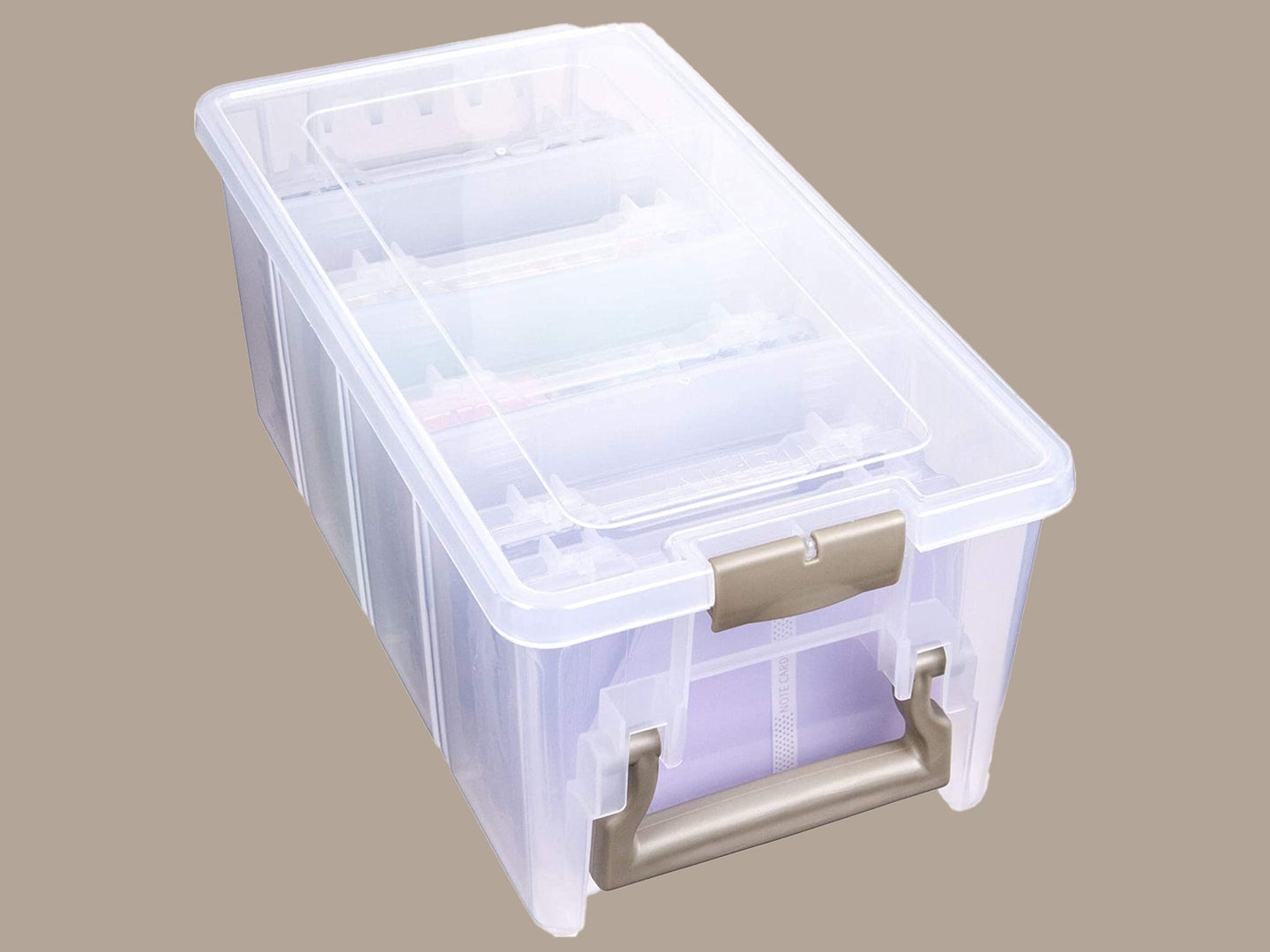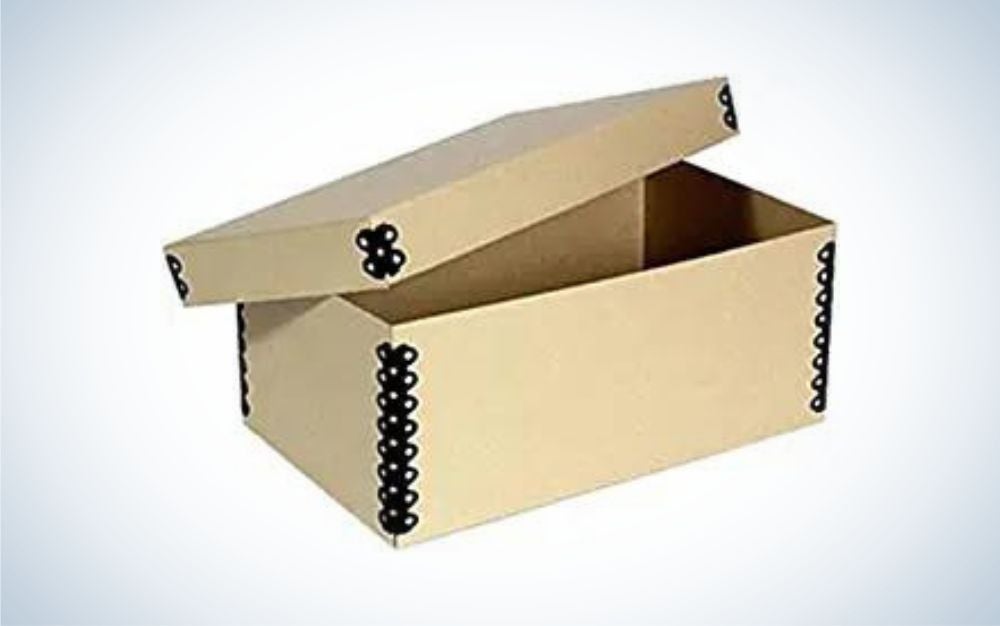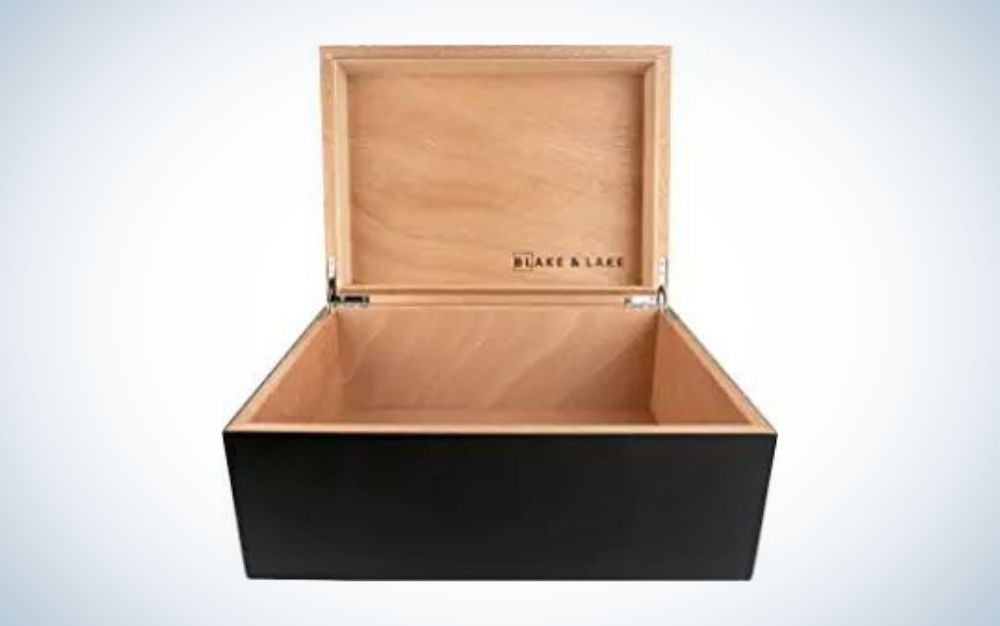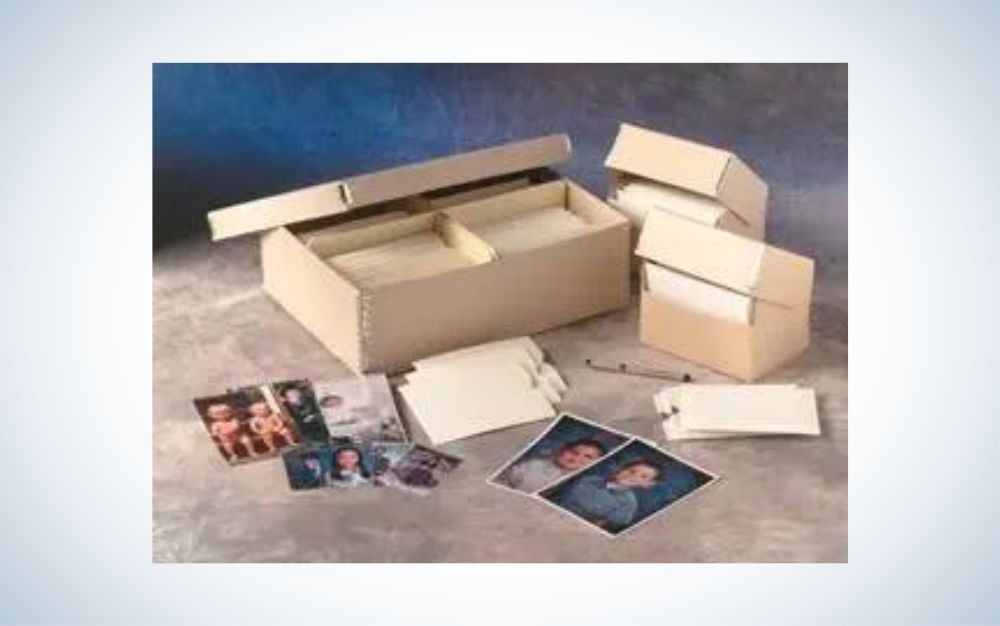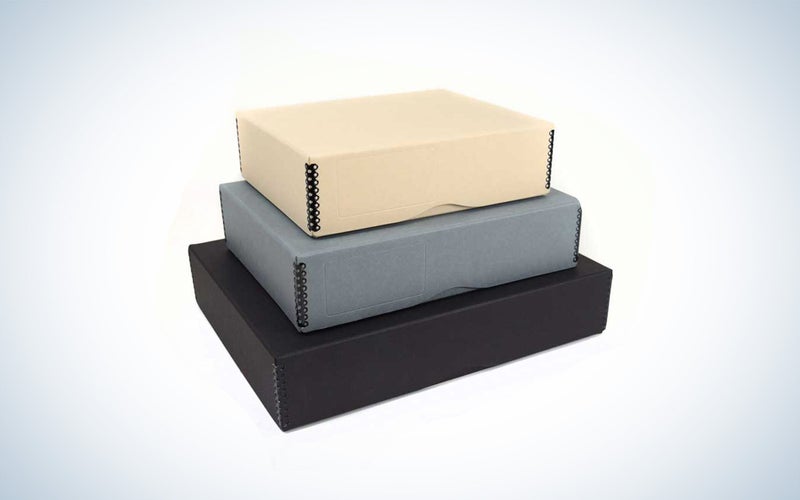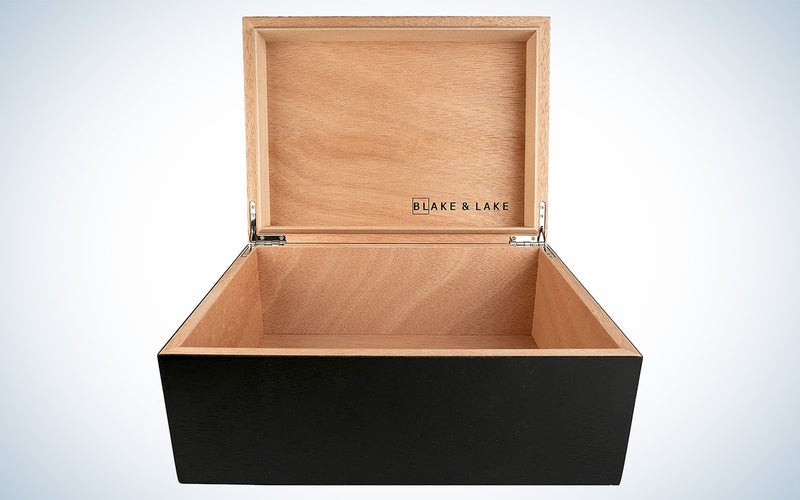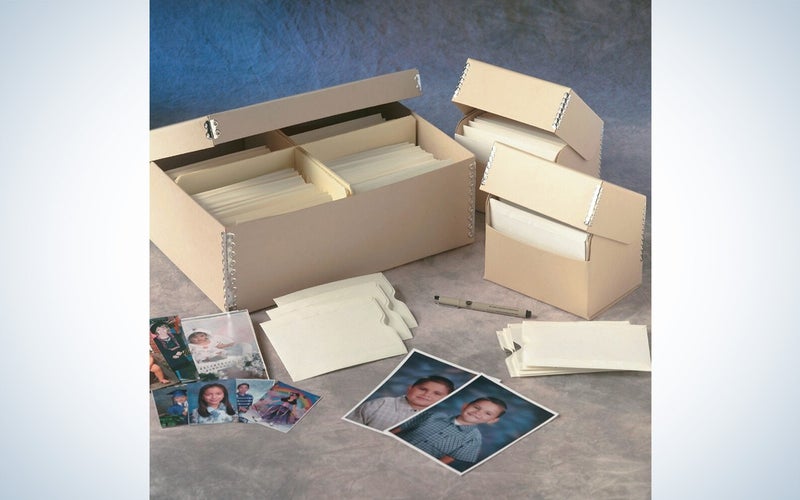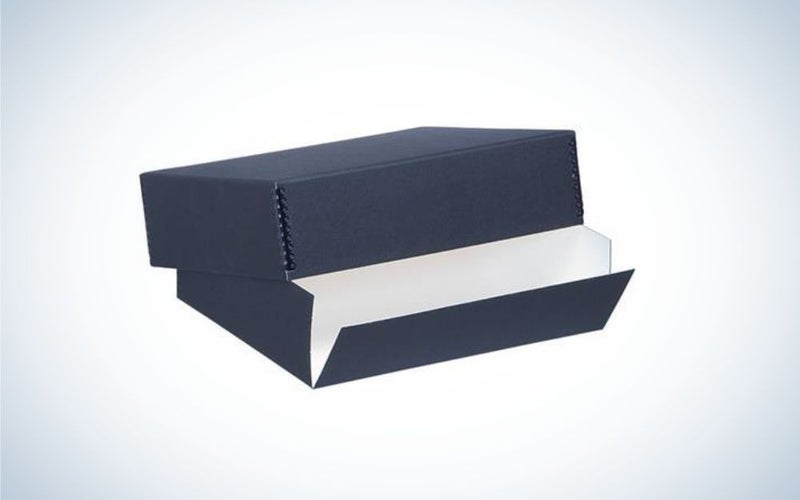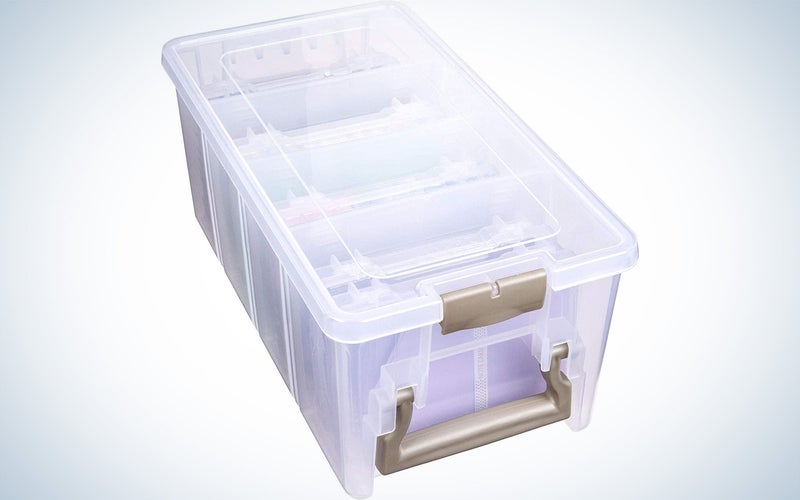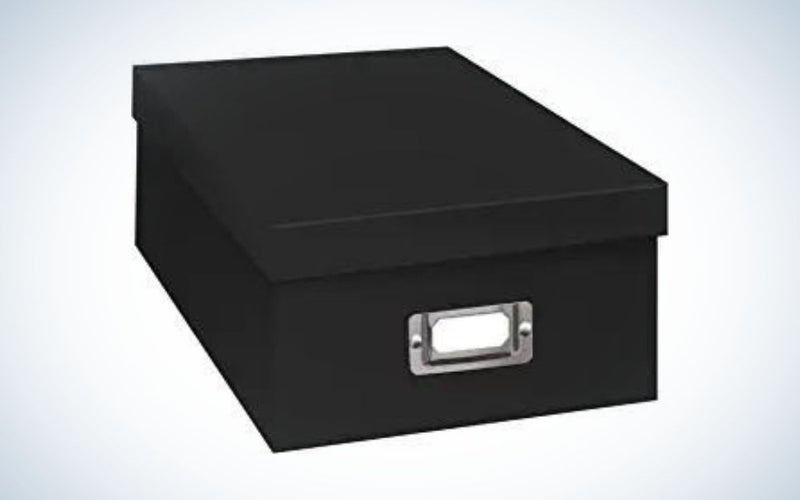We may earn revenue from the products available on this page and participate in affiliate programs. Learn more ›
Proper photo storage boxes can keep your prints safe and for decades and even centuries under the right circumstances. Without a storage solution, prints are prone to bending, damaged sun damage, and a host of other environmental threats. And while you can toss your photos in a shoebox or plastic sleeves in a three-ring binder, those methods can contain materials that harm prints in the long run. The best photo storage boxes will not only keep your prints organized but also protect them and even extend their life.
- Best overall: Archival Methods Metal Edge Short Top Box
- Best wooden: Large Wooden Box with Hinged Lid
- Best archival: Hollinger Metal Edge Photo Storage Box and Envelopes
- Best for large prints: Lineco 22×30″ Archival Print Storage Box
- Best plastic: ArtBin Semi Satchel Photo Storage Photo & Craft Organizer Set
- Best budget: Pioneer Photo Albums Photo Storage Box
Best photo storage boxes: Ratings & reviews
Best overall: Archival Methods Metal Edge Short Top Box
Archival Methods
Why it made the cut: Its shoe box size makes it useful for up to 1000 4×6 inch photos, and it’s archival so it will keep your photos safe for the long run.
Key features:
- Size: 10.5 x 6.5 x 4.5
- Material: Boxboard
- Color: Tan
Pros
- Metal edge clamps provide stability
- Versatile size
- Lid is tight fitting to keep out dust
- Acid and lignin-free
Cons
- Dividers and notecards must be purchased separately
Archival Methods is based in Rochester, New York, an area rich in photographic history thanks in large part to Kodak. The company makes all its products by hand, in-house, and is known for its quality.
The paper used in this box has passed the PAT and is acid and lignin-free. It is buffered with calcium carbonate to neutralize any acids that might sneak in. You’ll be able to trust that your box will stand up over time and keep your photos in excellent condition.
This box is designed for 4×6 inch photos. Because of its large size, it can accommodate roughly 1,000 4×6 inch photos inside. It will be a great option if you have many old family photos or want to build your archive of printed images. The lid fits tightly to keep out dust and is fully removable to make browsing easier when you want to reminisce. Unfortunately, it doesn’t come with dividers or notecards for organization, but Archival Methods sells compatible products or even kits to get you started.
Best wooden: Large Wooden Box with Hinged Lid
Blake & Lake
Why it made the cut: The attractive matte black finish makes it worthy of keeping on display in your living room, and it’s large enough to store other keepsakes.
Key features:
- Size: 10.75 x 8 x 5 inches
- Material: Wood (oak with cedar inlay)
- Color: Matte black exterior, unfinished wood interior
Pros
- Attractive design
- Comes in two colors
- Sealed to keep out dust and pests
Cons
- Not archival
If you want an attractive box to keep on display, this wooden option from Blake & Lake fits the bill. This particular version features a matte black finish with an unfinished cedar interior. Or you can also get a white oak finish if that suits your style more. In addition, the wood design means it is crush-proof–unlike paper boxes–so you don’t have to worry about prints getting bent inside.
The lid’s hinges lock at 90 degrees with open, keeping it in place while you browse. And it has a seal on the lid to keep dust and other contaminants out, protecting your photographs. Unfortunately, no information is provided relating to archival quality, so we would not recommend this box for those who want to prolong the life of their photos. But, it is an attractive, sturdy box for storing your photos.
Best archival: Hollinger Metal Edge Photo Storage Box and Envelopes
Hollinger
Why it made the cut: Hollinger’s box includes dividers to keep things organized and archival-quality envelopes to protect individual photos.
Key features:
- Size: 12 x 15.5 x 5 inches
- Material: Corrugated board
- Color: Tan
Pros
- Archival quality
- Comes with 100 envelopes
- Includes dividers
- Metal edges provide support
Cons
- Only 100 envelopes included
Hollinger has worked closely with organizations such as The Library of Congress and other institutional archives, making them a trustworthy source for archival products. Its photo storage box is one of the best options for those serious about preserving photos and building an archive.
It is also the best with dividers, which separate the larger box into four equal parts for organizational purposes. It comes with 100 archival-quality envelopes to put individual photos in for utmost longevity. Plus, you can write on the envelopes–we’d suggest using a number two pencil only–to make notes of the photo’s details for future reference.
The box is made of 40 pt acid- and lignin-free corrugated board and has chrome metal edges to make it sturdier. It is buffered to offer protection even if the photos you store in it have some acidic properties. And it has passed the PAT, so you can trust that it is safe for your photos for decades to come. If you use the envelopes for each photo, it can hold up to 750 4×6-inch photos. Or, without envelopes, you’ll be able to store up to 1,500 prints.
Best for large prints: Lineco 22×30″ Archival Print Storage Box
Adorama
Why it made the cut: This box can fit prints up to 22 x 30 inches and is made of a sturdy 60-point board of archival quality.
Key features:
- Size: 23 x 31 x 3 inches
- Material: 60-point board
- Color: Black
Pros
- Archival-quality
- Deep design allows for storing lots of prints
- Drop front design makes it easy to access prints
- Fully removable lid
Cons
- A bit pricey
Lineco is another one of the major players in the fine-art, archival world offering a range of products for storage, bookmaking, and framing. It makes archival photo storage boxes in a wide variety of sizes, but I greatly appreciate the large, 22×30-inch option for my large prints.
It is three inches deep, so you can store tons of prints inside if you need to. The drop front design makes it easier to pull out a photo on the bottom of the pile instead of risking bends and creases by lifting everything out first. I’ve unfortunately ruined many prints that way, so having the option to slide out only the one you need is an excellent feature.
As you would expect from this company, the box is acid and lignin-free and buffered. And it has metal edges, so you can stack boxes and not worry about it getting crushed.
Best plastic: ArtBin Semi Satchel Photo Storage Photo & Craft Organizer Set
Amazon
Why it made the cut: This clear photo storage box includes dividers and eight smaller boxes to keep your 4×6-inch photos organized.
Key features:
- Size: 7. 5 x 7. 2 x 5. 2 inches
- Material: Polypropylene plastic
- Color: Clear
Pros
- Clear design makes it easy to see what’s stored inside
- Comes with eight organizer cases for organizing
- Built-in handle for travel
Cons
- Not archival
This plastic container is a great way to keep your prints organized. The included smaller boxes hold 4×6-inch (or smaller) photos, so you can break up your prints into sections based on categories like trips you’ve taken or people in the images. And because it’s all clear, you can easily see what is on top of each box, making it easier to browse through photos when you want something specific.
Since plastic is a relatively new material (at least compared to paper and wood), we don’t yet know how prints will hold up over centuries. As such, we don’t recommend keeping photos in plastic for the extremely long term. But, this case is made of polypropylene, which is an inert plastic and thus one of the safest options.
Plastic does offer more protection than paper or cardboard alternatives in some ways. It will be crush-proof and do a better job of keeping out pests. And although it’s not watertight, if water should get spilled on it, your prints will still be protected.
Best budget: Pioneer Photo Albums Photo Storage Box
Amazon
Why it made the cut: It’s a very affordable photo box and comes in a range of colors to match your decor.
Key features:
- Size: 11.2 x 7.75 x 4.5 inches
- Material: Cardboard
- Color: Black
Pros
- Comes in many colors
- Acid-free
- Has a metal identification plate for labeling
- Includes index cards for organization
Cons
- No reinforced corners
- Not fully archival
Reliable photo storage doesn’t have to be an expensive endeavor. This Pioneer case is affordable and comes in nine colors to suit your decor. It includes an identification plate on the front so you can label it for better organization. And it comes with index cards for organizing the interior of the box.
It is made of acid-free board, which will keep your photos safe. It is not fully archival, however, so if you want to keep your photos safe indefinitely, you will want to choose a different option. It can hold prints up to 4×7 inches, and if you set them upright, you can store 1,100 of them. The lid fits on tightly to keep out dust, and it will also keep some moisture away. The cardboard is sturdy, but the corners aren’t reinforced like other options, so you may not want to move these around much or stack too many on top of each other when full.
Things to consider before buying photo storage boxes
Photo storage boxes are, at their core, simple products. It’s simply a box to keep your photos or artwork organized and safe. Yet, even with such a simple product, there are still things to consider when choosing the best storage box for your needs.
Archival qualities
The word “archival” gets thrown around a lot regarding photographs and artwork. Unfortunately, many brands use that term when their products don’t fully meet archival quality. This is largely because there are no official qualifications for what makes something archival. And it is frequently confused as being the same as acid-free, which is just one part of archival specifications.
In reality, achieving full archival quality is a rather complex process with many different pieces, but essentially means that something meets the quality needs of a professional archive. It relates to a box’s materials and how it is treated. A true archival storage box will be free of many things that can harm your photos. Acid is indeed one of these, but certain adhesives and plastics, as well as lignin, can also damage prints over time. Also, some boxes are made of buffered material, which neutralizes any acids introduced by the prints you store in them. For photos specifically, you’ll want a product that has passed the Photographic Activity Test (PAT), which ensures that materials are safe for photographs.
High-quality archival storage will cost you, however. If you are not overly concerned about your prints lasting centuries, you don’t need to invest in a high-end photo storage box. But, we would recommend at least getting something acid and lignin-free to keep your prints from decay over the years.
Maximum print size
Photo storage boxes are available in a wide variety of standard print sizes, so it’s important to assess what size the photos you want to store are. Family photos are typically 4×6 inches though you may have some up to 8×10 inches as well. But, if you are an artist or professional photographer who works with large prints, you will need to find something larger to accommodate the bigger print size.
Storage space
Once you know the average size of your prints, you will want to consider how many photos you need to store in your box. While fairly large boxes are available, with some storing up to 700 photos, most are more modest. If you need to organize lots of photos, you may need to stock up on a few boxes. And always consider how many prints you may generate in the coming year to give yourself a buffer for adding prints. If you find a box you particularly like, it might be worth ordering a few of the boxes in case the design changes or there are stock issues down the road when you go to get more.
Organizational features
Most photo storage boxes are just simple, empty boxes without any additional organization, while some come with dividers or even envelopes for organizing your prints. For some, throwing all the prints in a box is organization enough. But, if you are a stickler about organizing and want to separate your photos by categories such as dates or activity, look for boxes that either come with or provide optional dividers or envelopes. Just be sure that the organizational tools also meet your archival needs if that is an area of importance.
FAQs
How much do photo storage boxes cost?
How much photo storage boxes cost depends on their materials, their archival qualities, and, of course, their size. But, broadly speaking, you can find boxes for as little as $6.00 or as much as $400.
What is the best way to store old photos?
The best way to store old photos is an archival photo storage box. A true archival box will prevent premature decay, yellowing, and darkening of old photos. It will also keep them away from harmful UV rays and dust.
Ideally, you want a box that allows all prints to be stored flat without any bends. For the most protection, you can even buy individual archival sleeves, so there is no risk of photos getting stuck together. Lastly, humidity and extreme temperatures are hard on old photos (as with most things), so try to keep your pictures in a climate-controlled environment.
Also, although it doesn’t relate to storage, be sure to digitize those old photos as well as a backup in case something happens to the physical copies.
What is an archival box?
A true archival box is one that is made of materials that are safe for documents, photos, and artwork and will prolong the life of such materials. It should be acid-free, lignin-free, free of reactive chemicals, only utilize pH-neutral adhesives, and include buffered material. And it should pass the Photographic Activity Test and at least meet the standards established by preservation institutions.
Many products will throw around the term archival while not meeting the above specifications. And while you may not need something fully archival, you will want to look closely at the materials and specifications of a photo storage box to preserve those prints.
How do you store thousands of photos?
How you store thousands of photos is partly up to how you prefer to organize them and if you want to preserve them. If you’re going to keep the photos in good shape well into the future, look for archival-quality photo storage boxes. You will likely need multiple for such a high quantity of photos.
We’d also recommend finding a logical way to organize and categorize your photos, such as chronologically. If you want to get really serious, keeping a notecard (that is also archival) with information about the photograph is also a good idea. That way, future generations–or even yourself when reminiscing–can have more details about each image. A separate notecard is important because writing on the back of a print can damage it over time, especially if you use pen.
Is it better to store photos in paper or plastic?
It is better to store photos in paper than plastic if you want them to last centuries. While there are plastic storage boxes that specify they are acid-free, we don’t yet know how prints will react with plastic over that long of a time. We do know that archival paper or cardboard storage can successfully preserve photos.
Plastic storage has advantages if you are more concerned about keeping them safe for short periods of time. It will be sturdier than cardboard or paper boxes, keeping your prints from getting bent or crushed. And if you get a sealed plastic box, your prints will be fully protected from water, rodents, and insects.
Which are better, photo albums or boxes?
Though this is somewhat personal, boxes are generally better than photo albums. This is because they take up less space than albums and yet can hold more photographs. Also, unless you get high-end photo albums, many contain harmful adhesives, papers with acid or lignin, or plastic sleeves that are unsuitable for long-term storage.
Albums can make it easier to view the photos if you like to flip through them frequently, but for the life of the photos, a quality box will be the better solution.
Final thoughts on photo storage boxes
There are lots of reasons you may be considering photo storage boxes. Whether it be to preserve old family photos or simply to keep your own photos organized with no goal of them lasting for future generations, there are lots of great options to meet your needs. But be sure to look closely and read beyond acid-free statements if preservation is your goal.
Methodology: How we picked the best photo storage boxes
I have been involved in the photography industry for around a decade, much of which has been in the fine art world. Through talks with established artists, professors, and galleries, I have learned the importance of safely storing your artwork and photos. They instilled in me early on a good understanding of what archival means and how to handle art safely.
When selecting the best photo storage boxes, I used my personal experiences with particular companies and products as well as information from art and preservation communities. Since there are many different goals for photo storage boxes, I picked a variety of products from fully archival to more basic. Lastly, offering a selection of sizes was important, as were different price points.
